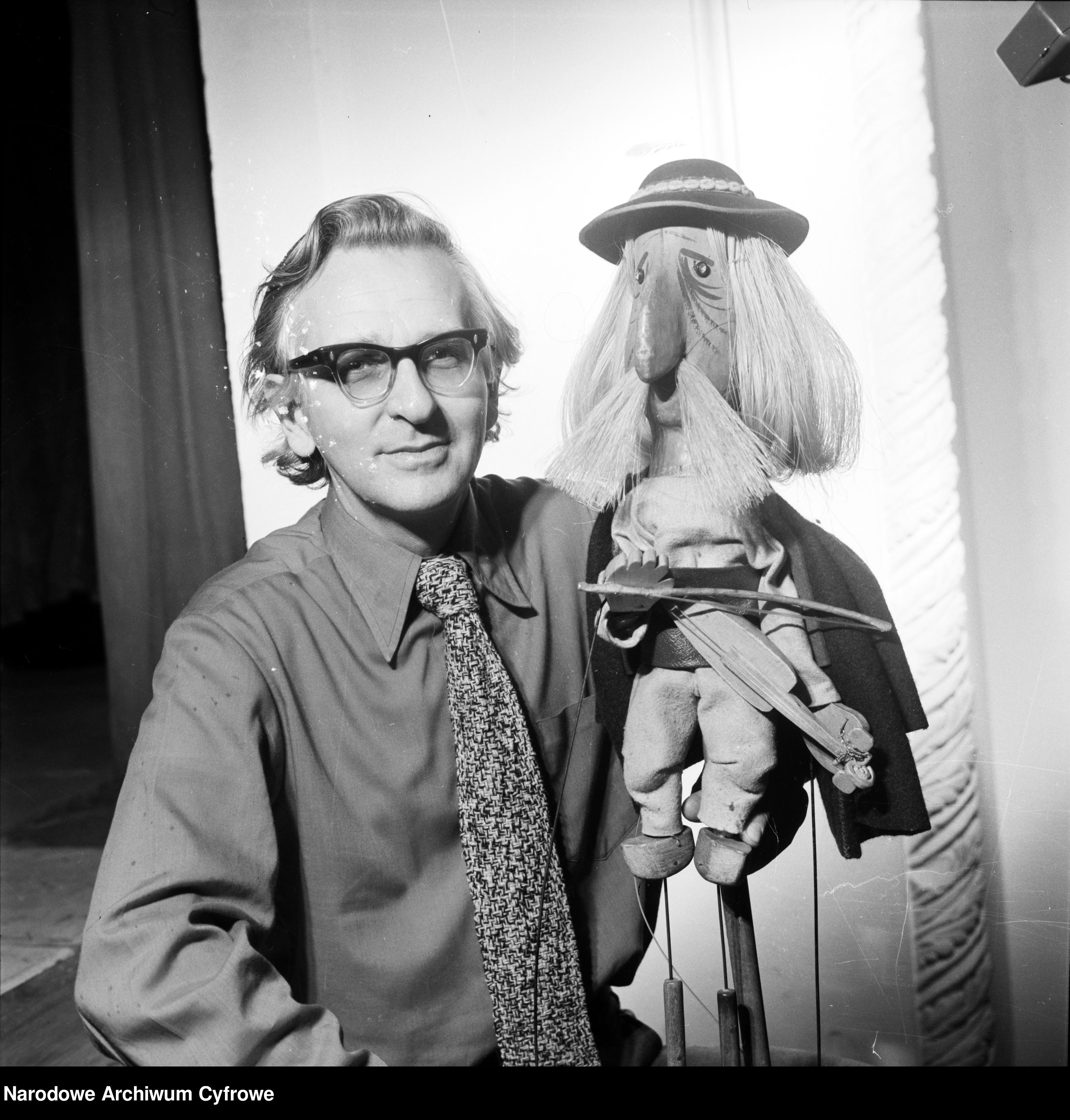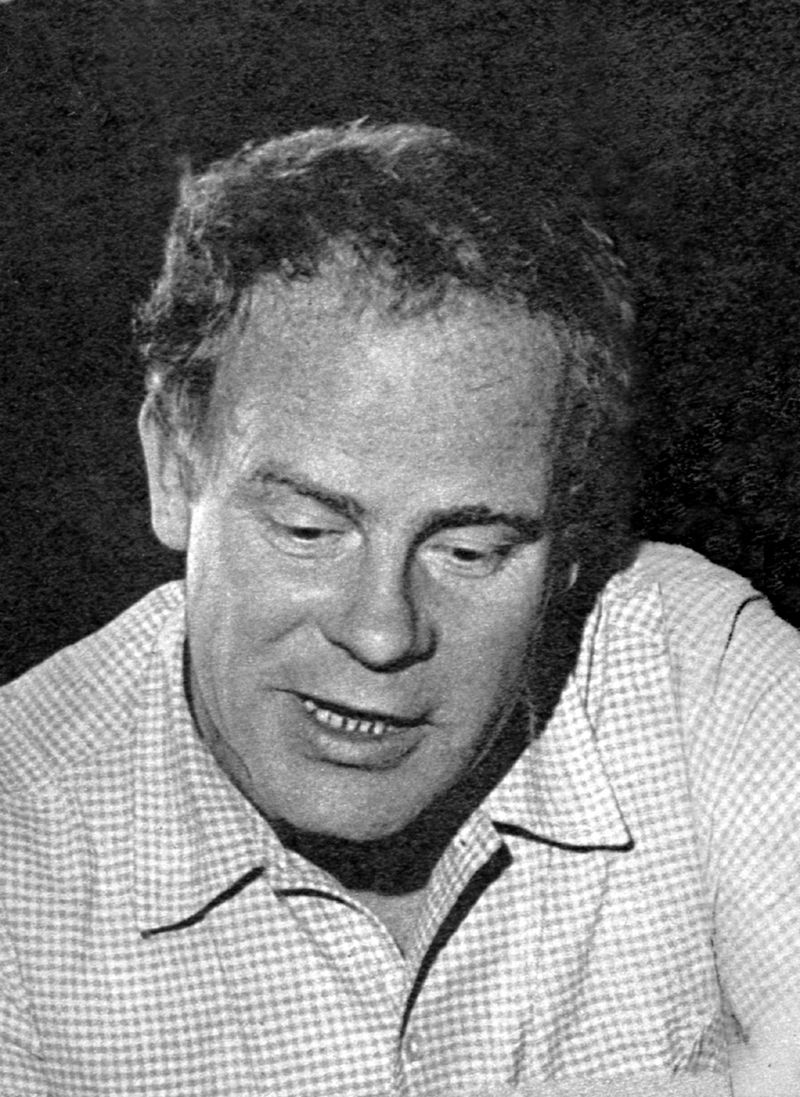Title of the work
Studio / Production Company
Country of the First Edition
Country/countries of popularity
Original Language
First Edition Date
First Edition Details
Orfeusz i Eurydyka [Orpheus and Eurydice]. Directed by Edward Sturlis, music by Stanisław Wisłocki. Łódź: Se-Ma-For, 1961, 12 min 30 sec.
Running time
Available Onllne
Orfeusz i Eurydyka at Ninateka (accessed: August 1, 2022).
Frames available at fototeka.fn.org.pl (accessed: August 1, 2022).
Genre
Animated films
Puppet films
Target Audience
Children
Cover

Frame from the animation. Copyright protected. Courtesy of Filmoteka Narodowa.
Author of the Entry:
Marta Pszczolińska, University of Warsaw, m.pszczolinska@al.uw.edu.pl
Peer-reviewer of the Entry:
Elżbieta Olechowska, University of Warsaw, elzbieta.olechowska@gmail.com
Katarzyna Marciniak, University of Warsaw, kamar@al.uw.edu.pl.

Retrieved from Narodowe Archiwum Cyfrowe (accessed: December 17, 2021).
Adam Kilian
, 1923 - 2016
(Illustrator)
Adam Kilian was an eminent Polish scenographer, graphic designer and illustrator. He was originally from Lwów; during WW2, he and his family were deported to Samarkand. There, his mother founded Teatr Lalek Niebieskie Migdały [Puppet Theatre of Dreams]. In 1944, he enrolled at the Faculty of Architecture of the College of Arts and Crafts in Nottingham. After graduation, he came to Poland and devoted himself to theatrical scenography, co-creating many performances – children’s spectacles and puppet shows and operas and repertory theatre. At first, he worked for his mother’s Niebieskie Migdały Theatre in Warsaw, then in Teatr Lalka [Theatre “Puppet”] where during a 60-year artistic career, he created many performances inspired by folklore, folk art and/or naïve art.
He also frequently worked for adult audiences at Teatr Współczesny [Modern Theatre] in Szczecin, Teatr Powszechny [Theatre for All], Teatr Narodowy [National Theatre] and Teatr Polski [Polish Theatre] in Warsaw or Teatr im. J. Słowackiego [J. Słowacki Theatre] in Kraków. In total, he created 323 scenographies for theatres in Poland and abroad. He also designed scenographies for 22 television plays, as well as 72 cartoons and animated puppet films. He illustrated many children’s books and cooperated with Płomyczek [Flicker], a popular weekly magazine for children. In addition, he designed posters and postcards.
He received many awards for his contributions to Polish culture (see the list of his awards at culture.pl), including his favourite, Order Uśmiechu (The Order of the Smile), the international award granted by children to adults for bringing them joy.
Sources:
Adam Kilian at culture.pl (accessed: November 25, 2021);
Adam Kilian at filmpolski.pl (accessed: November 25, 2021);
Adam Kilian at encyklopediateatru.pl (accessed: November 25, 2021).
Bio prepared by Marta Pszczolińska, University of Warsaw, m.pszczolinska@al.uw.edu.pl

Scanned by Jan Popłoński from "Ty i Ja", a Polish monthly, issue 5/1969, RSW Prasa, Warsaw, Poland. Retrieved from Wikipedia.
Edward Sturlis
, 1927 - 1980
(Director, Screenwriter)
Edward Sturlis (1927–1980) was an actor-puppeteer, screenwriter, and director of animations. Born in Moscow, he played in five Soviet films for children as a teenager. From 1945, he worked at Soyuzdetfilm as a scenographer’s assistant. In 1946, he came to Poland and began his career as an assistant at the Studio Filmów Kukiełkowych [Puppet Animation Studio] in Łódź (later known as Se-Ma-For studio). From 1955, he directed puppet animation as an independent creator.
His best-known works were episodes in the French-Polish animated series Przygody Misia Colargola [The Adventures of Colargol, the Bear]. He participated in creating many animated films for children. He was awarded collective and individual prizes in Poland and abroad: the Mention Spéciale at the Cannes Film Festival for Children and Youth in 1960 for Bellerofon [Bellerophon] and the Grand Prix of International Children and Young Adults Film Festival in Paris for Przygody Misia Colargola in 1972. He also produced animations concerning Greek mythology, such as Damon [Damon] (1958), Bellerofon [Bellerophon] (1959), Orfeusz i Eurydyka [Orpheus and Eurydice] (1961), and Danae [Danae] (1969).
Source:
Wikipedia (accessed: August 1, 2022).
Film polski (accessed: August 1, 2022).
Bio prepared by Marta Pszczolińska, University of Warsaw, m.pszczolinska@al.uw.edu.pl
Casting
Voice: Zbigniew Niewczas.
Summary
The animation starts with Orpheus, his head bowed in grief, wandering through a wasteland which symbolically represents a graveyard. The names of Orpheus and Eurydice are engraved on a tombstone in Polish and Greek. Orpheus calls upon the Earth to open up and let him in to find “her”. The ground cracks and the protagonist enters the Underworld where he has to face Cerberus. He plays his lyre and the music calms down the dog. He passes by Sisyphus on his way to Charon, who, once Orpheus plays him his music, ferries him across the river. Orpheus stands before Hades and Persephone and asks them twice to give him back Eurydice. When Hades becomes angry, Orpheus steps back and starts to play the lyre praising his beloved wife. He sings about their life together and her sudden death. Hades and Persephone are both touched by his story, and Hades says that Orpheus “with the power of love has defeated the power of hell”* (10:27). He agrees to bring Eurydice back to life on the condition that on their way back to the world of the living, Orpheus does not turn around to look at his wife. As they near the surface of the Earth, Orpheus steps into the light and then instinctively turns to see if she is following. Eurydice, however, is still in the shadow, she disappears, the crack closes, and the golden lyre falls on the gravestone.
* "Potęgą miłości zwyciężyłeś potęgę piekła."
Analysis
This short animated film retells the myth of Orpheus and Eurydice with puppet animation. The animation is conventionally simplified as the puppets can move in a limited way and do not have facial expressions. It is the music and the narrator’s voice that build the atmosphere. The narrator speaks for Orpheus and describes his perspective, although it is also used to express Hades’ statement and Eurydice’s plea: “Don’t look back”. The narrative is not chronological – Orpheus tells Hades how Eurydice died while pleading for her return to life. The core of the myth and all its key elements are shown in the film. The ambience is entirely Greek or as Greek as the popular culture imagines it – even the border of the crack in the ground is decorated with a meander motif; the walls of the Underworld are adorned with animal and human characters drawn in geometrical style. The boulder being pushed up by Sisyphus (02:07) is part of the design and the decorated wall.
The characters of Charon, Hades and Persephone do not look particularly classical. Charon is a muscular, young athlete wearing a golden mask, and Orpheus calls him “good Charon” (02:28). He seems to be a neutral figure – he just ferries souls across the river Styx. As for the rulers of the Underworld, they do not look the way Greeks represented them on vases. Still, being puppets, they resemble schematic, prehistorical figures of gods which could be associated with the Underworld. Here they are black symbols of an entirely dark world shown as a labyrinth of empty corridors. It provides the image of Hades as a dark and mighty lord but fair and, surprisingly, sensitive – music and a tale impress him and make him seem almost vulnerable and nearly human. Unfortunately for Orpheus, he looks back the moment he reaches the sunny side with the clear sky above him. Although he doesn’t break Hades’ condition (“you must not look at her until you exit the Underworld”*, 10:47), he loses his wife again. Does it mean that Hades was playing with him and death is irreversible?
The contrast between Hades’ realm and the world on the surface is extreme. The world of the living is presented as an idyllic landscape; light colors and a carefree atmosphere create an air of safety and enjoyment of life. When Orpheus plays, dryads dance and wild animals are tamed by the music. With Eurydice as his soulmate, Orpheus’ life is perfect. However, this idyllic image is disturbed when the musician has to leave to make sacrifices to Apollo. Aristaeus, here just an unnamed satyr, represents wildness and ugliness, upsetting the idyll, breaking its calm, and causing distress, fear, and finally, death. When Orpheus returns and learns about his wife’s death, he finds nature becalmed and almost dead. The beautiful setting turns into a grey, hollow graveyard with no sign of life, where Orpheus’ journey to the Underworld begins.
The animation presents the original myth in a simple manner, accessible to a child viewer. The educational value is undeniable: the film did not become obsolete or dated over the years. This is due to the universal dimension of the myth of love being stronger than death, at least for a little while.
The absence of traditional dialogues highlights the role of the narrator, Zbigniew Niewczas, the sound effects, and the music composed by Stanisław Wisłocki.
* "Nie spojrzysz na nią, dopóki nie wyjdziesz z podziemia."
Further Reading
Bańkowski, Antoni and Sławomir Grabowski, Semafor 1947–1997, Łódź: Wydawnictwo Studia Filmowego Semafor, 1999.
Ciszewska, Ewa, “Who Benefits from the Past? The Process of Cultural Heritage Management in the Field of Animation in Poland (The Case of the Se-Ma-For Film Studio in Łódź)”, Animation: An Interdisciplinary Journal 14 (2019): 117–131.
Kossakowski, Andrzej, Polski film animowany 1945–1974, Wrocław-Warszawa-Kraków-Gdańsk: Zakład Narodowy imienia Ossolińskich, Wydawnictwo Polskiej Akademii Nauk, 1977.
Ovid, Metamorphoses, X 8–63, vol. 2, trans. Frank J. Miller, The Loeb Classical Library, Cambridge, MA: Harvard University Press, London: William Heinemann, 1916, 64–69 (accessed: August 1, 2022).
Addenda
Production Team:
Director: Edward Sturlis,
Assistant Director: Teresa Puchowska-Sturlis,
Screenplay: Janusz Skoszkiewicz,
Music: Stanisław Wisłocki,
Sound: Jan Radlicz,
Design: Zofia Stanisławska-Howurkowa, Adam Kilian,
Text: Marian Piechal,
Voice: Zbigniew Niewczas.


